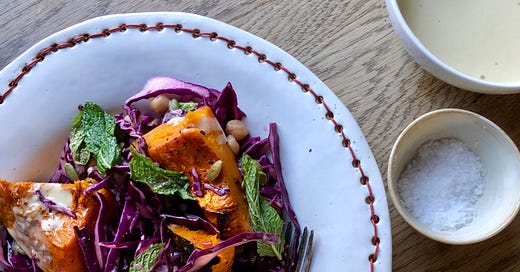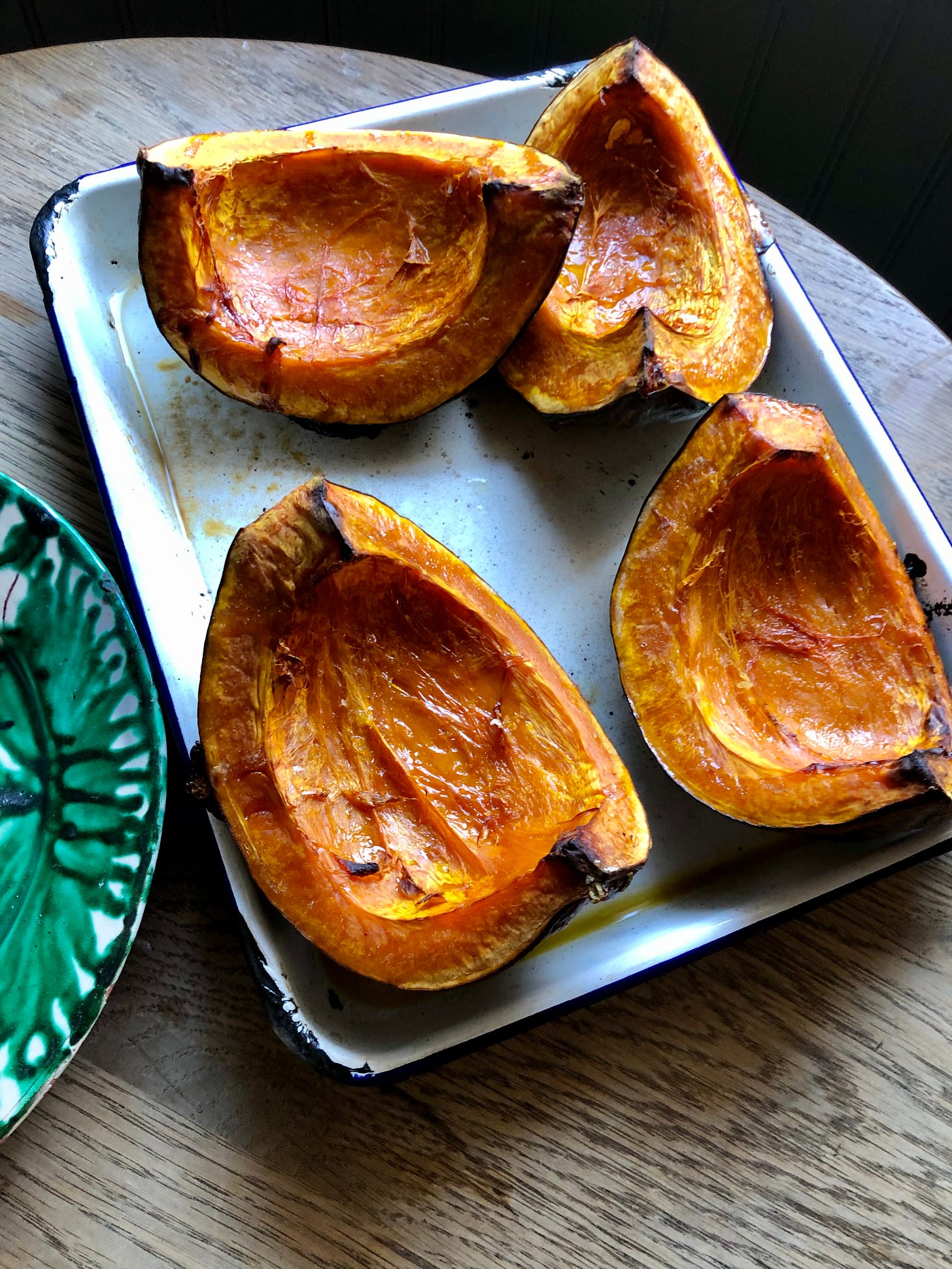Passive cooking, Kitchen prep, and a cluster of recipes
Winter squash (pumpkin) and chickpeas, a happy marriage
Kitchen Prep and “Passive Cooking”
Everyday home cooking for me is about having things on hand that can easily be thrown together to make a dish. Sometimes that is lunch just for myself, other times it is dinner for the whole family. As much as I have tried to meal plan, I am just not good at planning ahead. It was probably my biggest challenge running a professional kitchen, I thrive in off-the-cuff cooking, and anything else just feels hard. That said, there are other ways to plan, so that every meal is not a gigantic production or so overwhelming that you give up before you even begin. This way of organizing my home cooking has helped me eat better, waste less and make everyday cooking feel like less of a huge undertaking.
Essentially, I prep ingredients so that they are ready to use at the last minute. This maybe doesn’t sound so profound, it definitely is something I always did at work, but for the longest time I didn’t have the head space or the energy to do the same at home. But trust me, it really makes a difference, even just the smallest amount of prep work today will make your future self sing with gratitude. I like to call it “passive cooking”, that is cooking things that don’t require a lot of attention -to be used later on- while you are doing other things. A lot of items on my weekly prep list (no I don’t actually make a list, but in my head there is the idea of one) are passive cooking items- beans and whole grains for example. Or putting some beets (beetroot) on to boil, or roasting a tray of vegetables. All things that don’t take much effort if you already happen to be in the kitchen but will later on be the difference between ordering take out for dinner instead of having a home cooked meal.
My basic prep throughout the week looks somethings like this:
a pot of beans or lentils
A whole grain such as brown rice, farro or kamut
Salad dressing
Vegetables- either roasting, steaming, grating
Sometimes I also boil some eggs or cook a piece of fish such as salmon or make tuna salad/chicken salad/egg salad/tofu salad…you get the point
Roast chook/broth (not necessarily every week)
Soup if I feel like it
Importantly, I do not do everything all at once, although sometimes I get inspired and make a bunch of things on one day, usually this prep is spread throughout the week, cooking to replace items as they are used up. It helps to date everything if you are doing this, and as a general rule, use it within 5 days to be safe. Anything I don’t think I will use, I pop in the freezer for another time.
Chickpeas and Winter Squash
This week I made a pot of chickpeas, soaking them overnight first and then, after draining off the soaking water, cooking them with fresh water to cover by about 3 inches, a bay leaf and an onion that I simply cut in half. Leaving the skin on the onion does color the chickpeas and their cooking liquid a rather greyish brown, but it has flavour and nutrients and I am ok with it. I add salt (a good amount, to taste) 5 minutes before the end of cooking time, which can take anywhere from 40 minutes to an hour and a half depending on how fresh your chicks are- I just keep trying them- and I generally cook them to be on the softer side because that way they make creamier hummus if I decide to do that later. I don’t add baking soda, some people swear by it to soften the chickpeas, as I have never had a problem with tough chickpeas in all the years I have been making them like this. I cool and store them in their cooking liquid- discarding the onion and bay or using them in a soup- saving the juice to add to soups and hummus, and to keep my little peas tasting perky.
I also had a lovely winter squash/pumpkin that I got from the market. It is a Tetsukobuto (there is a good chance I got that name wrong) a Japanese pumpkin, not unlike a Kabocha with sweet, bright orange flesh, only much harder to peel. I simply washed it to remove any dirt, cut it in quarters and scraped out the seeds, then drizzled it with olive oil and salt and roasted it, skin on, at 400*F (200*C) for about 30-40 mins until soft and beginning to caramelize. Once cooked, the skin is edible (unlike some squash, Butternut, for example whose skin is not pleasant to eat even when cooked). I like to simply cut it up, skin on, and toss it through a salad. I made 2 salads from said squash this week- one with a ginger dressing, chickpeas, avocado, green onion, cilantro (coriander), beets and a boiled egg, the other with a tahini dressing, chickpeas, red cabbage, mint and pepitas toasted with Aleppo pepper-both were delicious and different enough that I did not feel like I was eating the same thing every day. I also made a pumkin soup, which I have decided I prefer to be vegan, rather than made with chicken broth. I used miso to add depth and richness and a little ginger for warmth. I served it with a drizzle of the tahini dressing from the chickpea salad and some of the spiced pepitas, and a bowl of brown rice, a perfect lunch.
Below are recipes for Miso Pumpkin Soup, Ginger dressing, Tahini sauce and Chili Pepitas.
Miso Pumpkin Soup
Roasting the squash intensifies the flavour, and as it can be done ahead of time, means that the soup comes together quite quickly, just scrape the flesh from the skin before you proceed. This recipe makes about 1 quart (1ltr) , enough for 2 serves, but it can easily be scaled up as you need.
Keep reading with a 7-day free trial
Subscribe to Still Life With Lemon to keep reading this post and get 7 days of free access to the full post archives.






